For nearly 120 years the Pagoda has served as a beacon to generations of us who have called Reading and greater Berks County home. What is its story? How does such a unique Japanese structure end up on a mountain in Pennsylvania? What’s happening now? You have likely noticed the building has been closed and in need of millions of dollars worth of repairs. Maybe most importantly what’s next? How can we navigate the future of this building and bring it into the 21st century so our children and grandchildren can enjoy it for another 120 years? I joined the board of the Foundation for the Reading Pagoda back in January 2024, and I hope to shed some light on these questions below.
The Reading Pagoda is by far the most iconic structure in Berks County, and one of the most unique tourist destinations in Pennsylvania. I have mentioned in some of my content that it is the only structure of its kind in the United States, which has been met with a bit of skepticism. Our pagoda is the only in the world with a fireplace and chimney. The stone base, while not atypical of authentic Japanese structures, was constructed with Pennsylvania fieldstone from the quarry which once stood in its place. These two elements make it an almost a perfect blend of Japanese and Pennsylvania German, which in its own way is unlike any other out there. Plus, all you need to do is google, “Pagoda’s in the US” to see that while there are two small peace Pagodas in San Fransisco and New York, nothing looks similarly or rivals the size and scope of the Reading Pagoda. Beyond that, ours is also the oldest currently standing. Have no doubt, it is indeed an anomaly.
History of the Reading Pagoda
William Abbott Witman
The August 10th, 1906 Reading Eagle published an article titled, “Mt. Penn Will Have Japanese Pagoda”. It explained that City Councilman William Abbott Witman would be constructing the novel building as a summer resort on the site of his former quarry. Witman’s life and career are worth the subject of its own article, which you can read here. As some context to why Witman would decide to build such a unique structure, you need to understand he was a very controversial and not well-liked figure by the time this article ran in 1906. At this same time Witman was on trial to lose his city council seat for two counts of conspiracy as alleged by the Tax Payer’s League. William, who owned the quarry with his brother John, entered into a contract with the city in the summer of 1905 to provide truck loads of stone for street paving and other projects. Many in the public viewed it as unethical that a councilman’s business would be used for city projects, and obtaining it through his brother was a shady way of doing so. In addition to that, there was discrepancy between the weight of the loads and amount paid, William’s involvement, and a convenient loss of receipts. Ultimately, Witman was found guilty in local courts, but appealed his way up to the Pennsylvania Supreme Court, where he was also found guilty and made to forfeit his position on council.
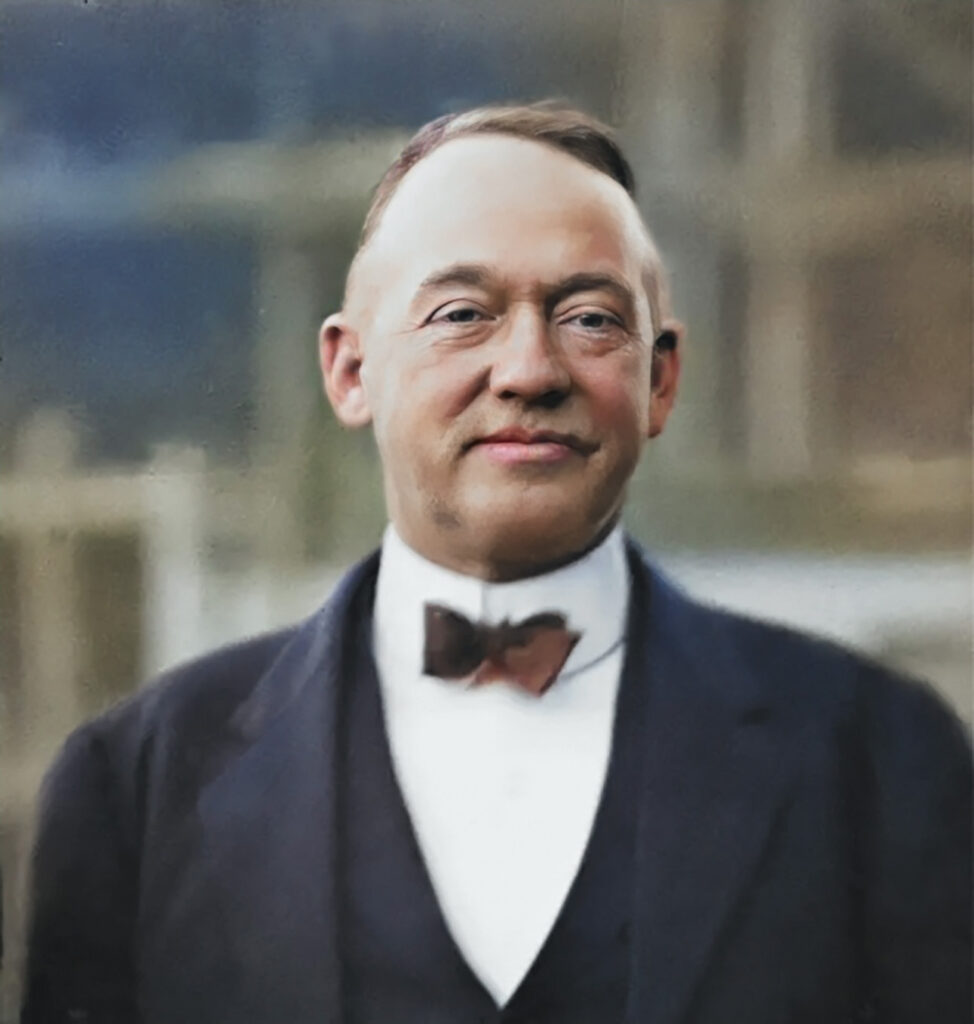
Not only were the people of Reading annoyed with having their view of Mount Penn blighted by an ugly quarry, it was also a constant reminder of corruption occurring in their local government. Witman, probably feeling the heat, decided to turn the quarry into a beautification project. Also, determined to not let the trial undermine his position in the public eye, he also announced his campaign to run for Reading’s Mayor in December of 1907. He lost in the Democratic primary. It would be the first of many unsuccessful attempts to run for Reading’s Mayor.
The Pagoda was completed in 1908 at a cost of $50,000 and allegedly modeled after Nagoya Castle, a battle fortress in Japan. It was designed and constructed by Charles and James Matz. Witman, looking to use the building as a resort, wanted to obtain a liquor license. He was met with much resistance from the community. In February 1909, 619 Reading citizens signed a petition to block him. Their reasoning was, “a hotel is not necessary at that point for the traveling public and that the sale of intoxicants at the proposed stand would tend to make the Pagoda a terminus for parties seeking liquors. It goes to say that women and children are won’t to frequent that section of the Boulevard for outings and walks, and that these pleasure trips would have to be stopped if the place was licensed.”
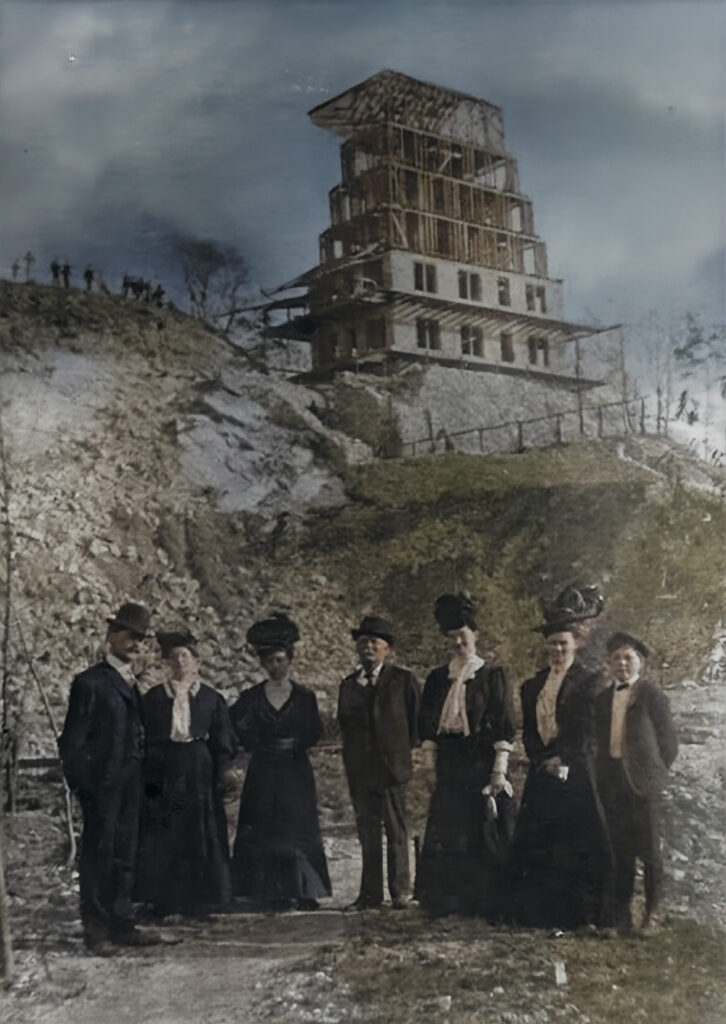
It is important to remember that the property in which the Pagoda sits was originally in Lower Alsace Township. Witman’s defense in this was that only citizens of the township where the license is sought should be able to petition it. Witman provided a counter-petition of 125 Lower Alsace residents who were in favor of the license being granted. It is also worth noting that the Summit House Hotel, which was due north of the Pagoda up Skyline Drive would have been licensed and serving during this time. Despite this, Witman was refused a license officially a few weeks later. It is merely speculation, but it seems to me like this manufactured roadblock was personal.
You may have heard rumors of the Pagoda being used as a brothel of sorts. I have absolutely no documentation to confirm it, but have it under good authority that there is indeed truth to this. I imagine it was most likely a place those who knew Witman could go for a quick private room rather than a formally run establishment. Whether that was the original intention or a consequence of not gaining a liquor license to do “honest” business is anyone’s guess. Regardless, this must have been a very short affair, as Witman would only own the building for roughly three years before selling it at a loss.
Jonathan Mould
Witman would default on his mortgage for the structure, and it was sold to Jonathan Mould on December 23rd, 1910 for nearly half of what Witman paid to build it. Only four months later on April 21st, 1911 Mould deeded the building to the City of Reading.
Jonathan Mould was born in New York but moved the Reading in 1871 to manage his hometown’s goods store that was branching into Pennsylvania. After that business was sold he opened his own dry goods store on Penn Street in 1887 called J. Mould & Company. Mould also served as a director of Farmer’s National Bank, through which he would end up owning the property, as the bank financed Witman’s mortgage.
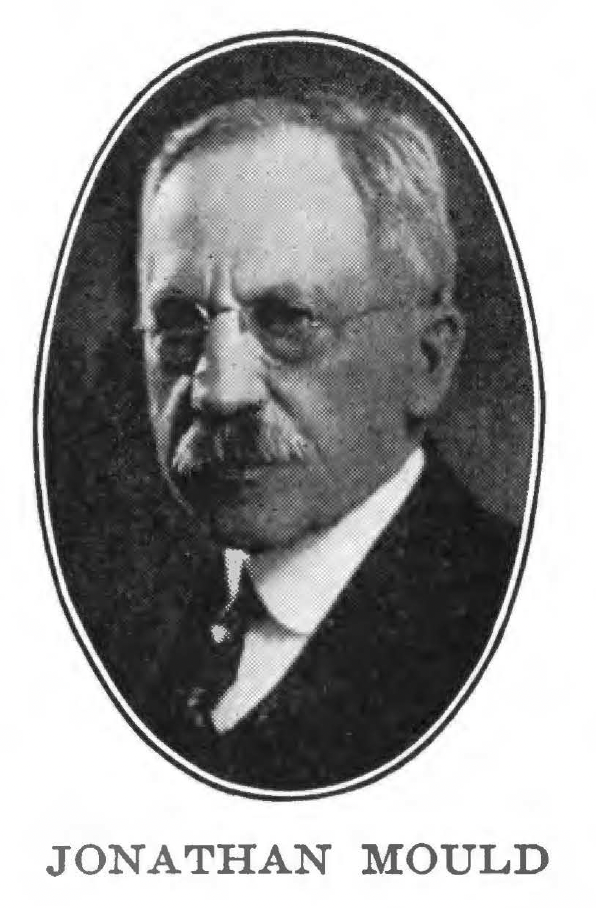
Mould’s gift to the city was an overture of his efforts at conserving the untamed land around it. In 1914 he founded the Berks County Conservation Society which held its first-ever meeting inside of the Pagoda. This was a pioneering move, as at this time the modern conservancy movement in the United States was in its infancy. The organization’s efforts were instrumental in ensuring the rest of Mount Penn went untouched by development. Beyond that, the organization planted trees to cover up the deforestation caused by the various quarries on Mount Penn.
Today, we have Mount Penn Preserve spearheading much of that conservation legacy.
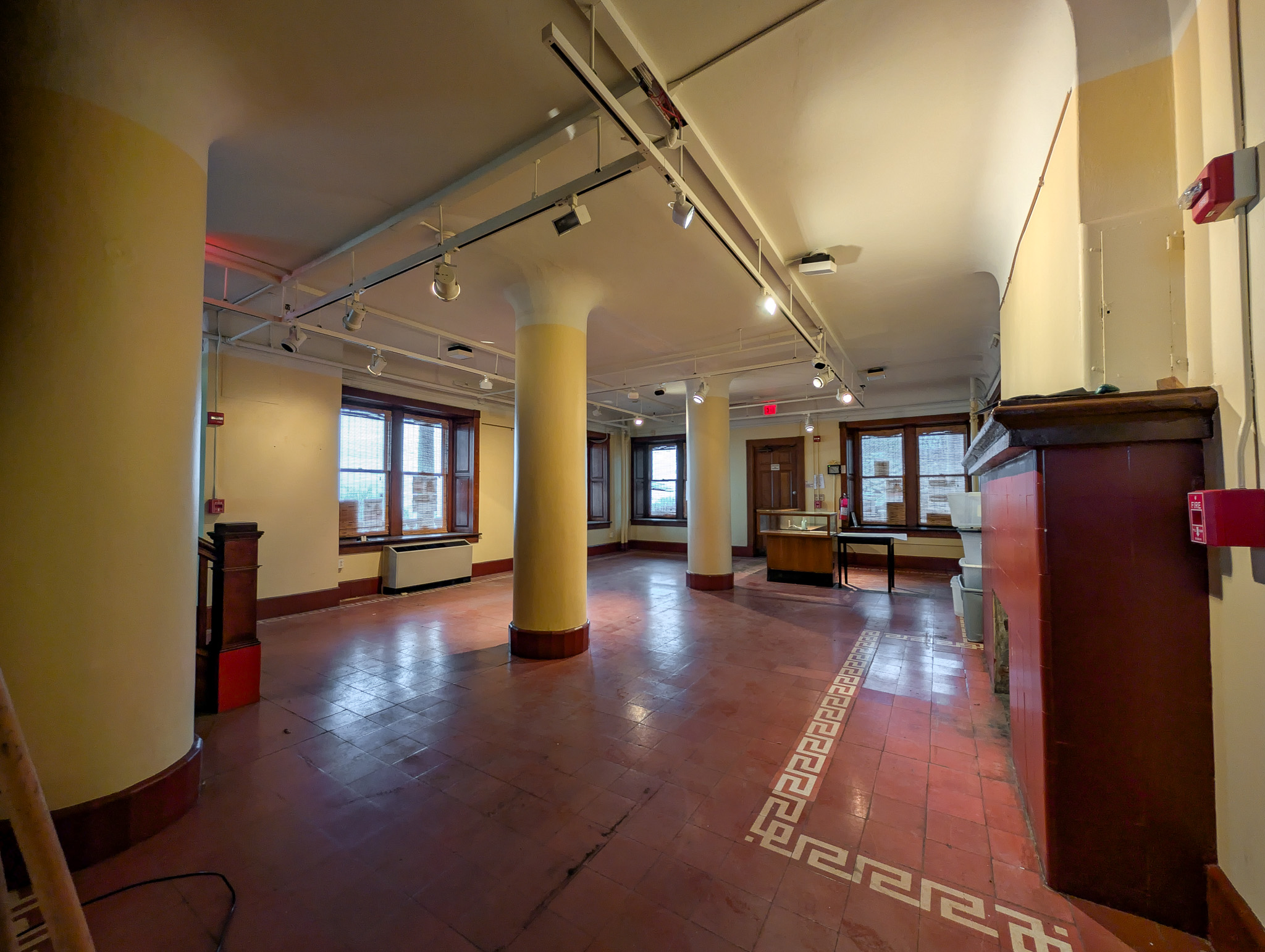
City of Reading Ownership
This isn’t the first time the Pagoda has sat closed for a number of years. After obtaining ownership, the City didn’t get around to opening the building to the public until over three years later. Immediately they had to make a number of improvements to the building. The water pressure was lacking so the city needed to lay a new pipeline from a water main. They also installed electricity and had to furnish the building as it was completely empty. It was dedicated officially on September 5th, 1914 by Jonathan Mould.
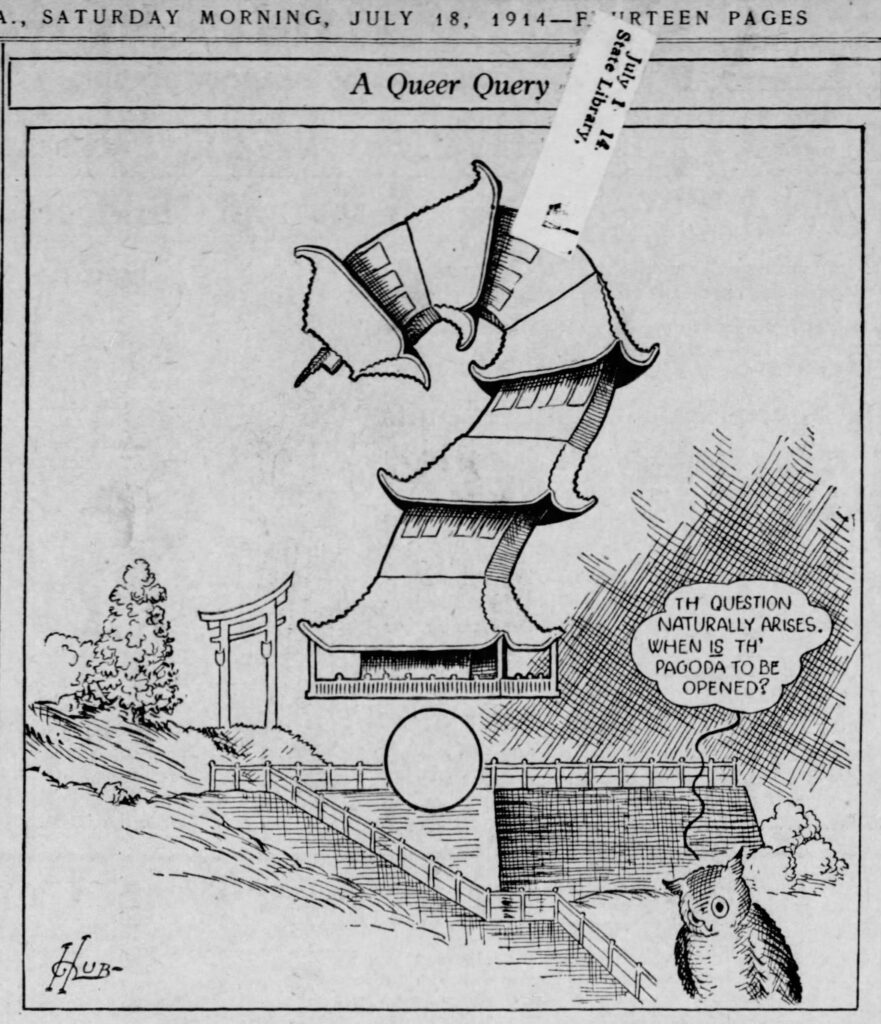
You may know that a dawn church service is held each Easter morning at the William Penn Memorial Fire Tower up skyline drive. This tradition actually began in 1914 at the Pagoda. It was held annually there until 1937 when it moved to the fire tower to accommodate a growing crowd.
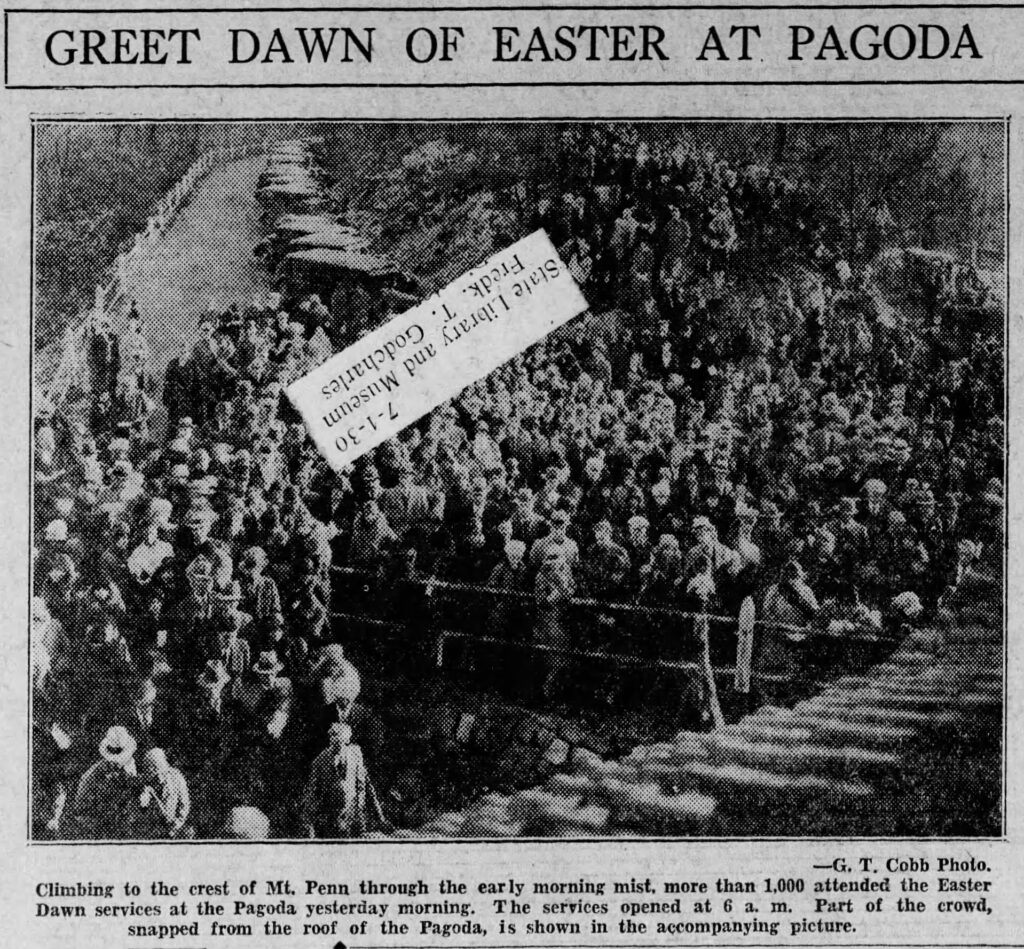
In 1917 it was reported in the Reading Times that the Boy Scouts were using red and white lights atop the Pagoda to signal morse code messages.
The Reading Police Department began using the Pagoda as a substation in 1920, and the March 26th Reading Times reported that people arrested in that vicinity were held in the basement of the Pagoda until the morning when they would be taken downtown. They too used the beacons from the Pagoda to send urgent morse code messages to other officers stationed around the city. In 1922 the Times reported that the Pagoda signals were used to direct police to bootlegger raids as a result of prohibition.
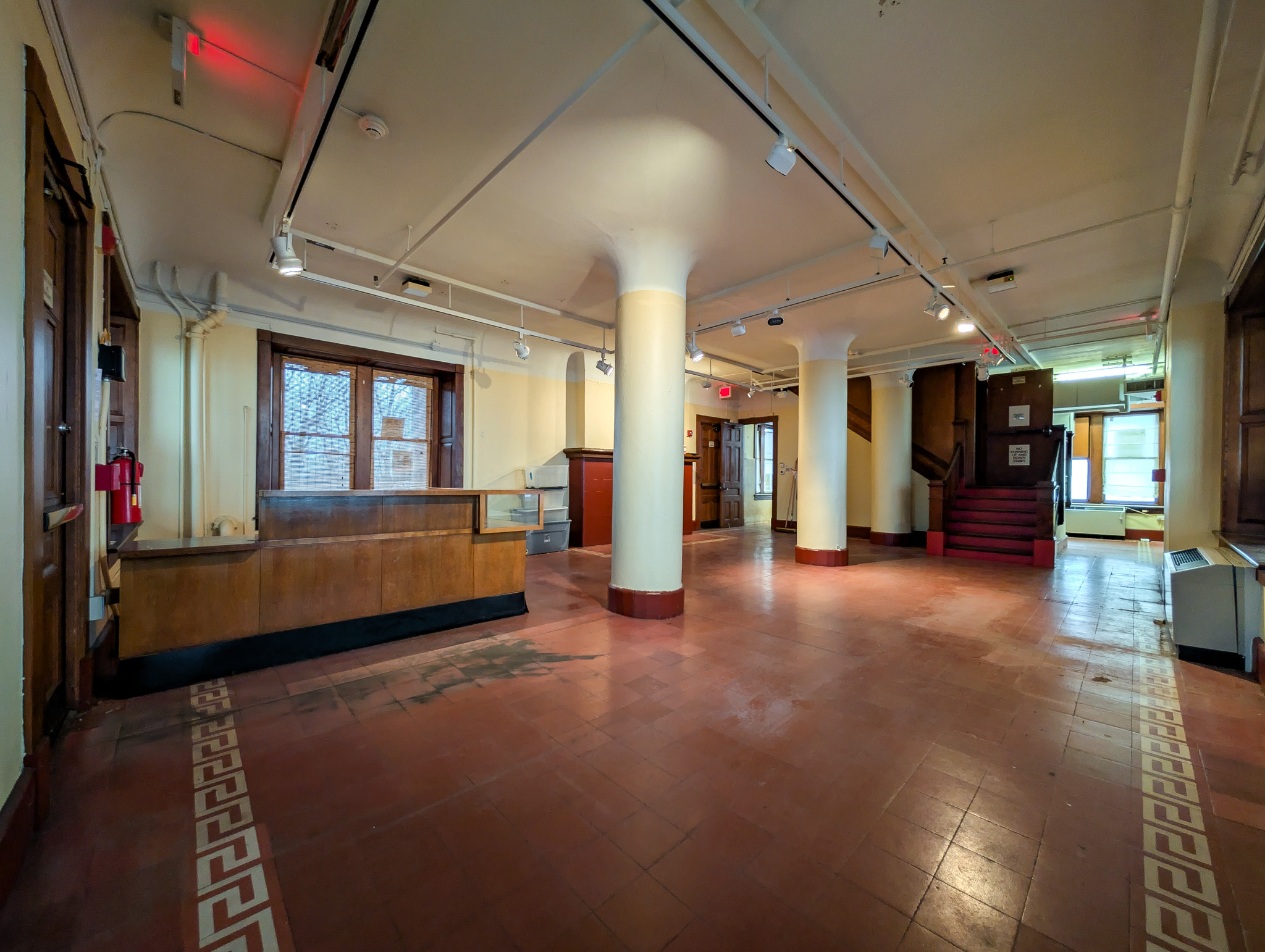
On June 2nd, 1922 an article published in the Times titled, “It cost $2 to visit Pagoda by taxicab”, in which the Pagoda’s security guard lamented the astronomical price cabs were charging to drive people up the mountain. Accounting for inflation, $2 equates to about $37 in 2025. A week later on June 10th an article titled, “Pity the Poor Jitney Driver” ran where the taxi cab driver gave his side of the story. “Yes, I charge $2 to take a person to the Pagoda and I am thinking of making the price $3. The city is to blame. No one else. If you have an automobile you know what we are up against. Mineral Spring park is closed [to automobiles] and the worst dumps of a road in the county is ours to get from the hill.”
The landmark quickly became a popular tourist destination for those visiting the area, and the October 16th, 1922 Reading Times reported that the Pagoda saw over 8000 visitors the day prior. By the end of that year, City Council announced improvements to the property justified by the fact that the Pagoda had over 122,000 visitors in the year 1922.
The city applied for a license to begin broadcasting a radio station from inside the Pagoda in March of 1923. In 1932 the highest ever recorded total of tourists visited the Pagoda at 175,922.
In 1941 the road leading up the mountain from city park, formerly called “Pagoda Road”, was renamed Duryea Drive in honor of Charles E. Duryea, a local pioneer automobile manufacturer.
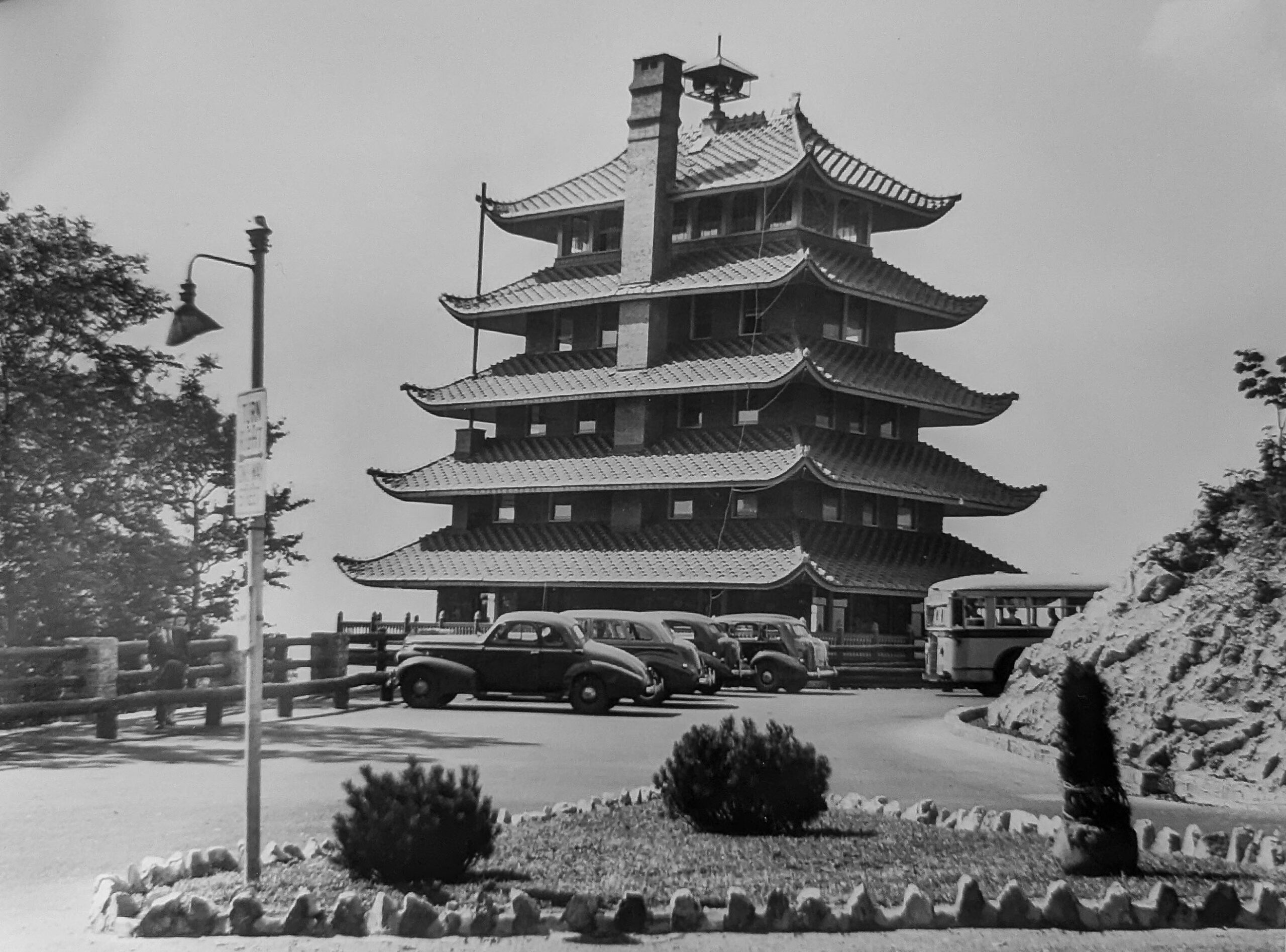
During World War II times were tumultuous. In March 1942 the city ordered that the Pagoda’s lights would be blacked out for the duration of the war, lest it serve as a guide for enemy airmen. The original wooden balconies that surrounded the Pagoda had rotted and were unsafe for public use. Citizens wrote to council and asked them to tear it down, as it represented a culture that was killing our servicemen in the war. The wooden balconies were replaced by the current stone porches in 1949.
In 1960 modern red neon tube lighting replaced the old incandescent light bulbs which had lined its eaves. Unfortunately, the new lighting didn’t stand up well against the elements the Pagoda faces on top of a mountain, and were burnt out or damaged within a couple years of being installed.
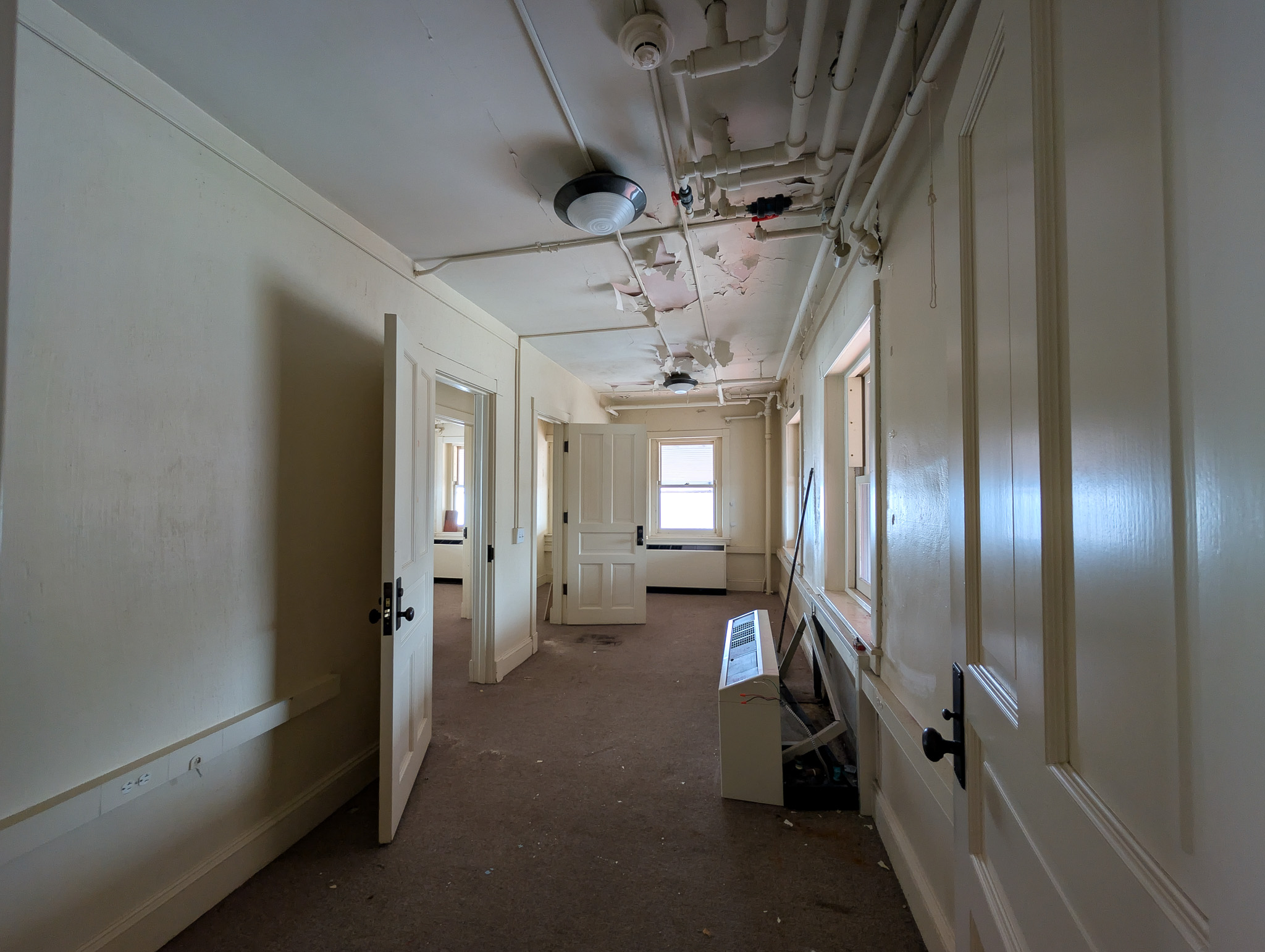
A scathing letter published in the Reading Eagle in 1965 which was titled, “Neglected Pagoda”. The writer noticed that the Pagoda’s exterior neon lighting was turned off at 11 o’clock every night, “when the proprietor of the gift shop leaves the premises because it would not be safe to leave them burning when no one was around.” Apparently there were also several roof tiles were missing, “the roof leaks, bringing with it all the threats commonly associated with that kind of carelessness.” Things reached critical mass in the summer of 1969. A gaping hole opened in the parking area and wall deteriorated and fell as a result of heavy rains.
Due to this dire need of repairs, a new citizen organization formed that same year. Initially called, “Save the Pagoda Skyline Committee”, eventually becoming just “Pagoda-Skyline Inc.” Their first brainstorming sessions produced plans to develop the mountain. These ideas included a free-standing glass elevator on the east side of the Pagoda for access to all floors and a chair lift from City Park to ride up the mountain. Those never quite panned out.
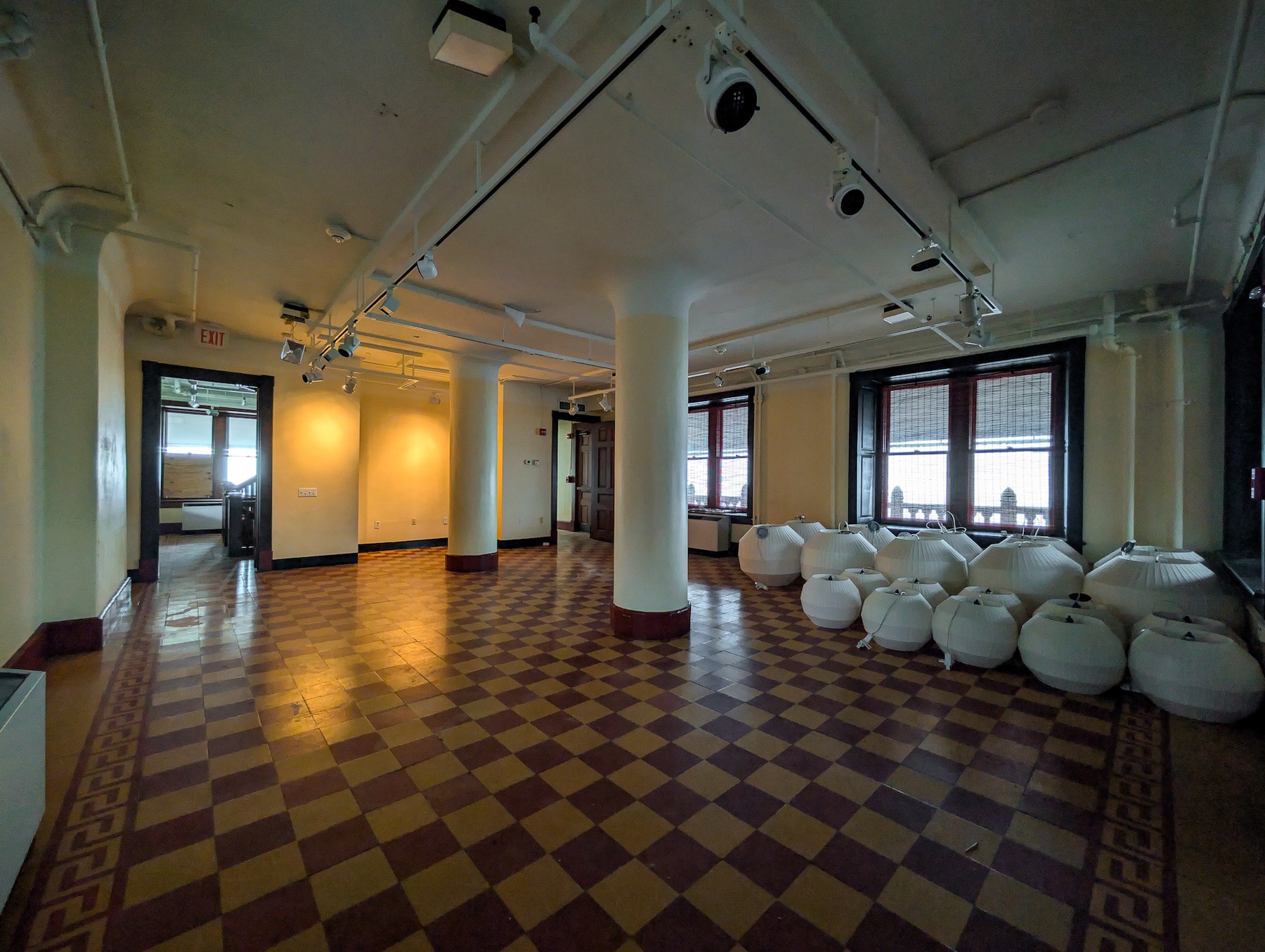
The electrical issues would prove to be nearly catastrophic. Around 10:45pm on the evening of November 3rd, 1969 a short-circuit sparked a fire which damaged the eastern side and eaves on the second story of the structure. Luckily Glenn Miller, who leased the building from the city, was closing up for the night and smelled the smoke. One can only imagine how much may have burned had no one been there.
By September 1970 Pagoda-Skyline Inc. announced a $1.2 million improvement project with a tentative completion date of 1975. It included new electrical, repainting the exterior, and updates to the interior.
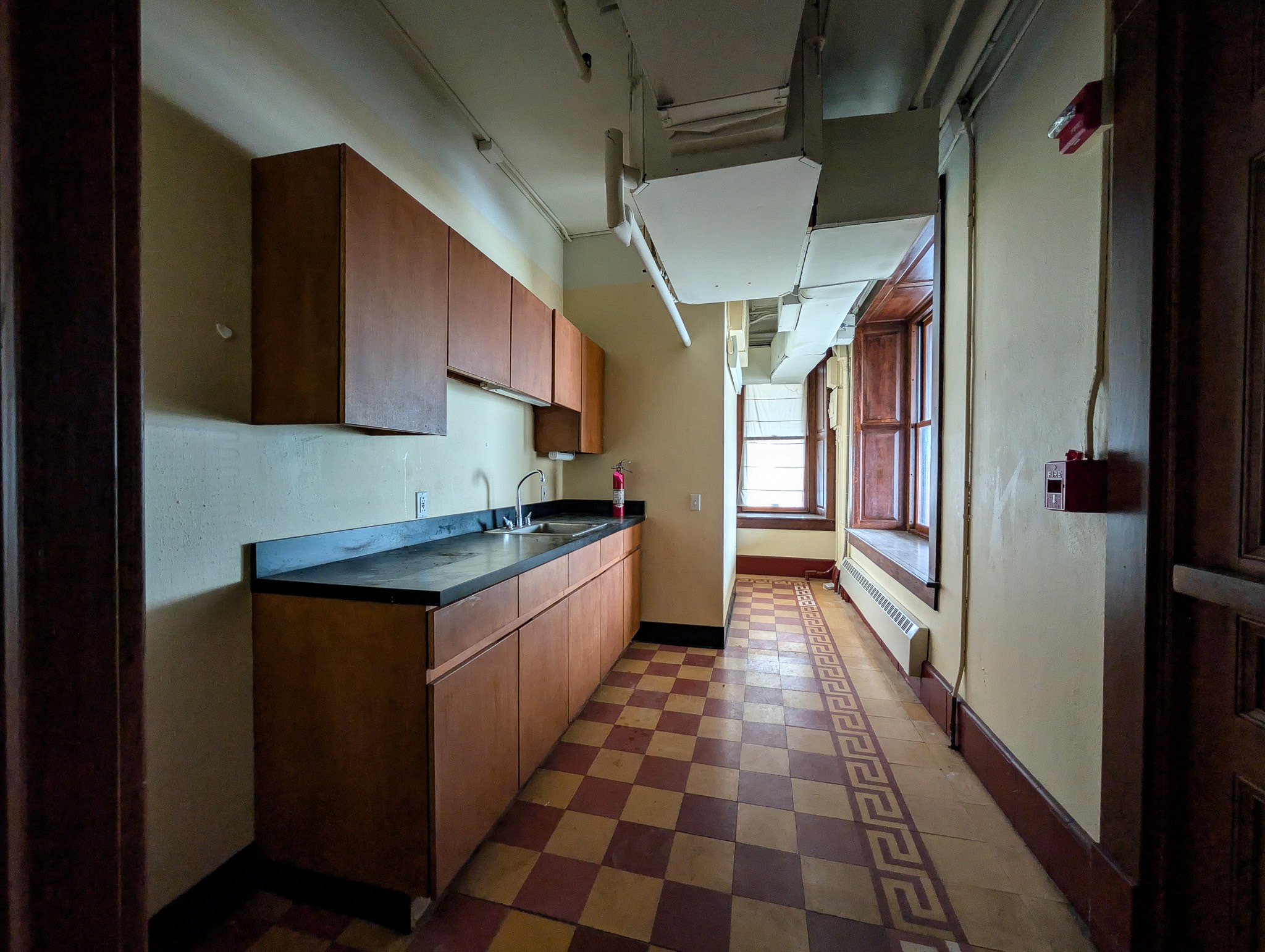
In 1971 twenty new lions heads were cast for each corner of the eaves.
Again the Pagoda was darkened in 1973 under Nixon’s request for conservation during the energy crisis.
Local artist Bess Bast was contracted in 1973 to create two water dragon sculptures to place atop the Pagoda to add to its authenticity. These dragons, called “Shachihoko” in Japanese mythology, are believed to protect the buildings they sit on from fire. Bast created the styrofoam molds and C.J. Rhoads Foundry in Northmont cast them in metal. They were officially set into place in June 1975.
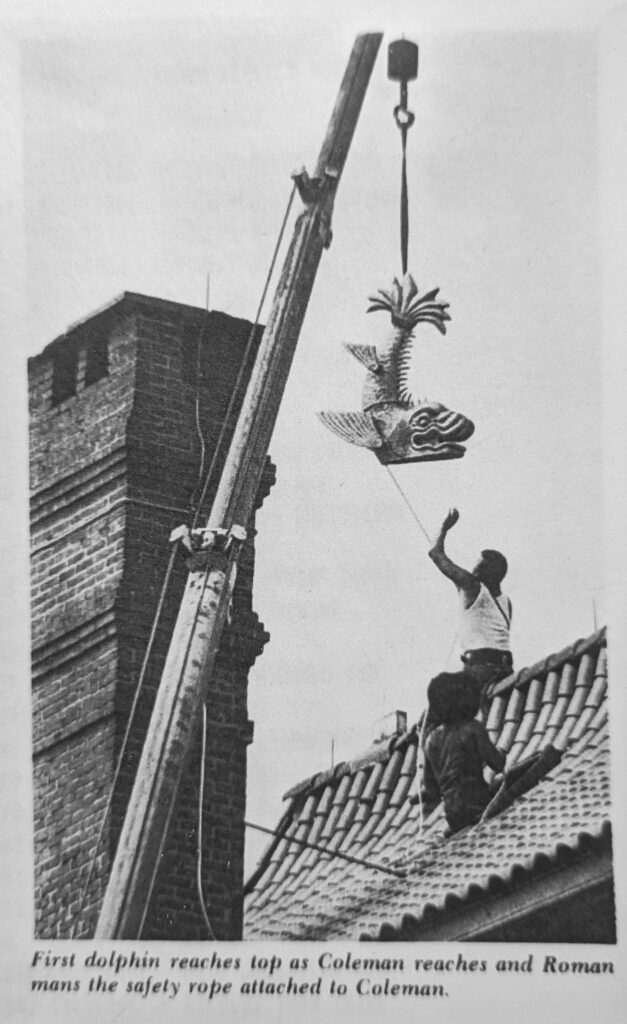
The Pagoda was rededicated in July 1973 and reopened for the first time in nearly 4 years. This included a new Tori gate which was designed in likeness of the original – which was taken down by the city when they acquired ownership in 1911. Chie Yueng Hong, owner of the Far East Restaurant obtained concession rights and operated a small cafeteria on the main floor. His new signature menu item was a hot dog topped with duck sauce. Also during the 1970s that age-old tradition of the Pagoda blinking its lights at 9 o’clock p.m. on Christmas Eve to signal that Santa was nearby was revived. The tradition dated to the 1940s, but was abandoned for some time prior due to the electrical issues. Sound familiar?
Again the exterior lighting was botched during this renovation. This time the contractor installed interior lights instead of exterior lights, and within a year they malfunctioned and were rendered unusable. This led to a lawsuit between the city and contractor.
Yet again the Pagoda suffered a minor electrical fire in January 1980 which damaged the northwest corner of eaves on the second floor. New neon lighting was reinstalled on the eaves by the end of the year. A concrete retaining wall was constructed at the parking area around this same time to replace some of the stone WPA project walls built four decades prior.
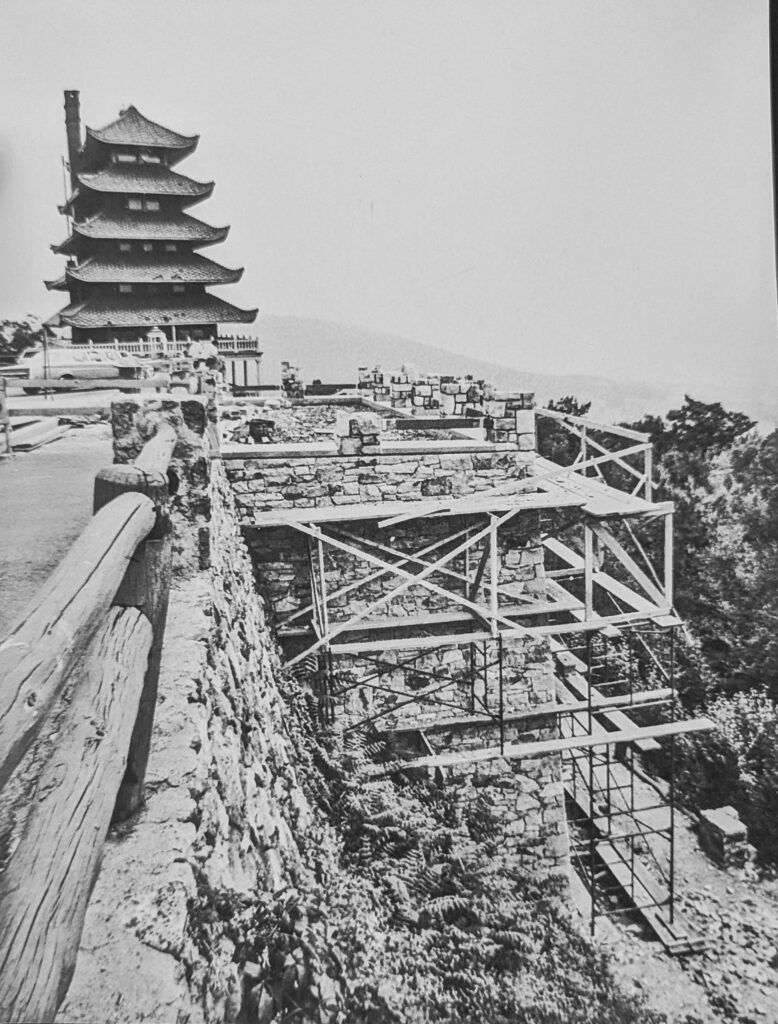
In 1988 an Allentown based development company announced plans to build a 250-seat restaurant adjacent to the Pagoda and have a bridge between the two structures. That never came to fruition.
The building continued to deteriorate and by 1991 it again needed work to the tune of nearly $1 million. These renovations ended up costing $2 million and were completed in May of 1994.
By 2003 citizens again called for the city to repaint and replace roof tiles.
Patty Pagoda’s appearance became a local Groundhog’s Day tradition in 2006.
In 2008 the building went through yet another $1.5 million overhaul which included new LED strip lighting replacing the old neon tubes. These would be the last significant renovations made. The Pagoda celebrated its 100th birthday that year. It continued operations until the COVID-19 pandemic in 2020 in which it closed and has not since reopened to the public. An assessment was done on the property and stone retaining walls in 2023 which provided the scope of repairs that needed to be made before reopening.
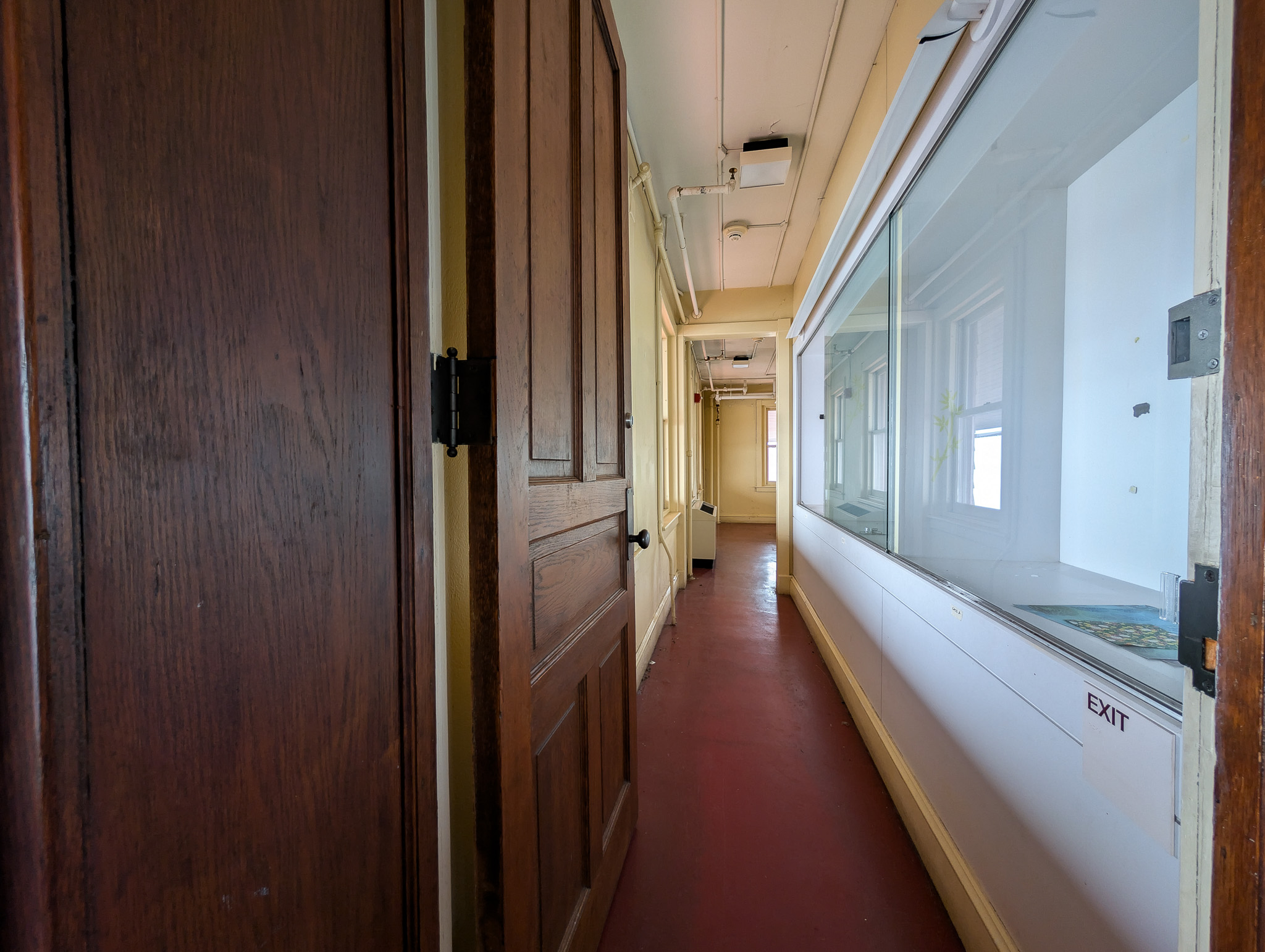
Bell on the top Floor of the Reading Pagoda
The Bell that hangs on the top floor observation area was cast in 1739 in Hanno, Japan. Witman bought the piece from an importer when he was constructing the Pagoda. It is inscribed with Japanese characters which are the names of the bell’s donors and an “end of world” prophecy. The history of the bell and the way it was obtained is a story in itself, so I will be making it the subject of its own future article.
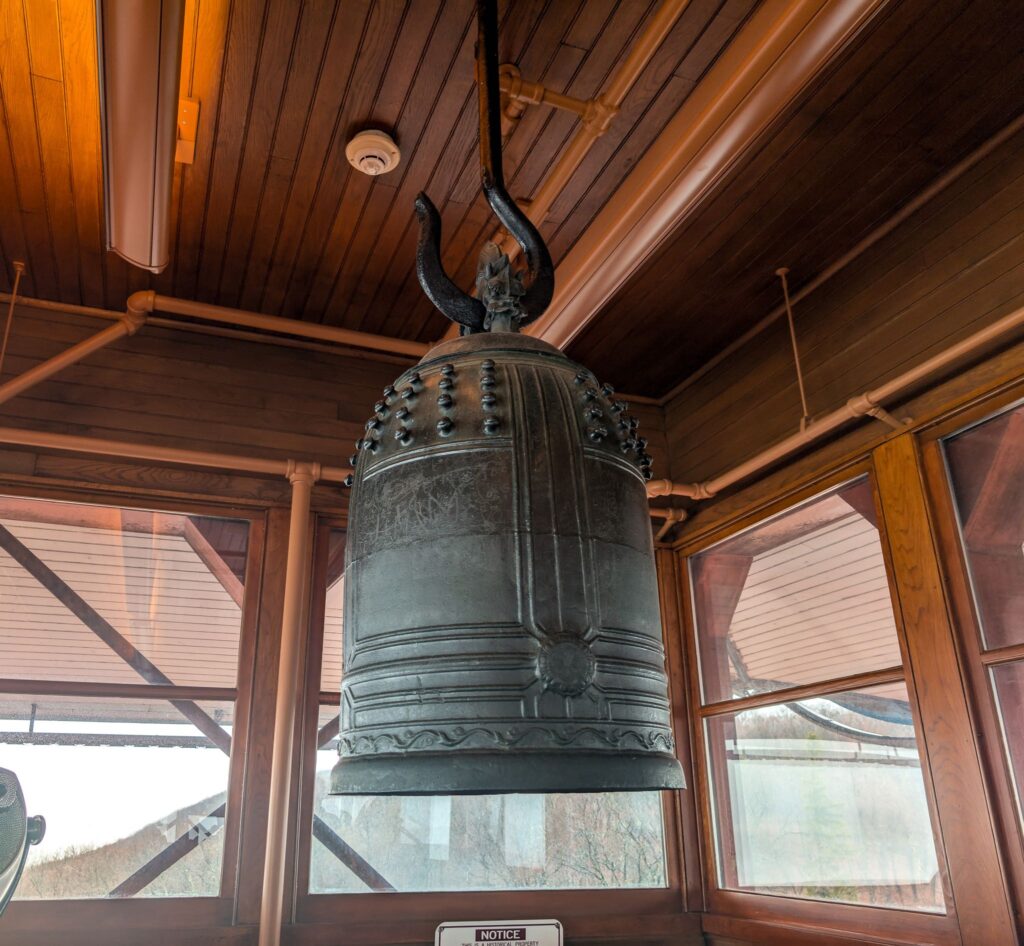
Crime
If you think all of this is beginning to sound like Groundhog’s Day, you are right. New decade, same problems. If someone tries to tell you that the Pagoda has been undermined by vandalism and other criminal activity – feel free to remind them these are the same problems the city faced in the 1940s, 1950s, 1960s, 1970s and beyond.
In the 1958 vandals broke in and destroyed $200 worth of recently made improvements to the top floor of the building.
Two teenagers were kidnapped while they were parked on skyline drive (a popular past-time for couples) near the Fire Tower in August 1969. They were then murdered near Dreamland Park.
In 1974 someone set the exterior entry bathrooms on fire which led to them being locked when the Pagoda was closed.
The entire mountain became a trash dumping ground in the 1990s which cost the city hundreds of thousands to clean up.
This struggle certainly isn’t new.
The most recent version came in the form of loud music and late night nuisance for years at the expense of neighbors nearby. Last June all of it came to a head when a violent altercation between dirt bikers and a cop was caught on camera and quickly published for the entire world to gawk at. It kicked off an initiative to gate off Skyline Drive between the Fire Tower and Angora Drive between dawn and dusk. Things have been quiet since that incident in June and the gate system is in the process of being implemented.
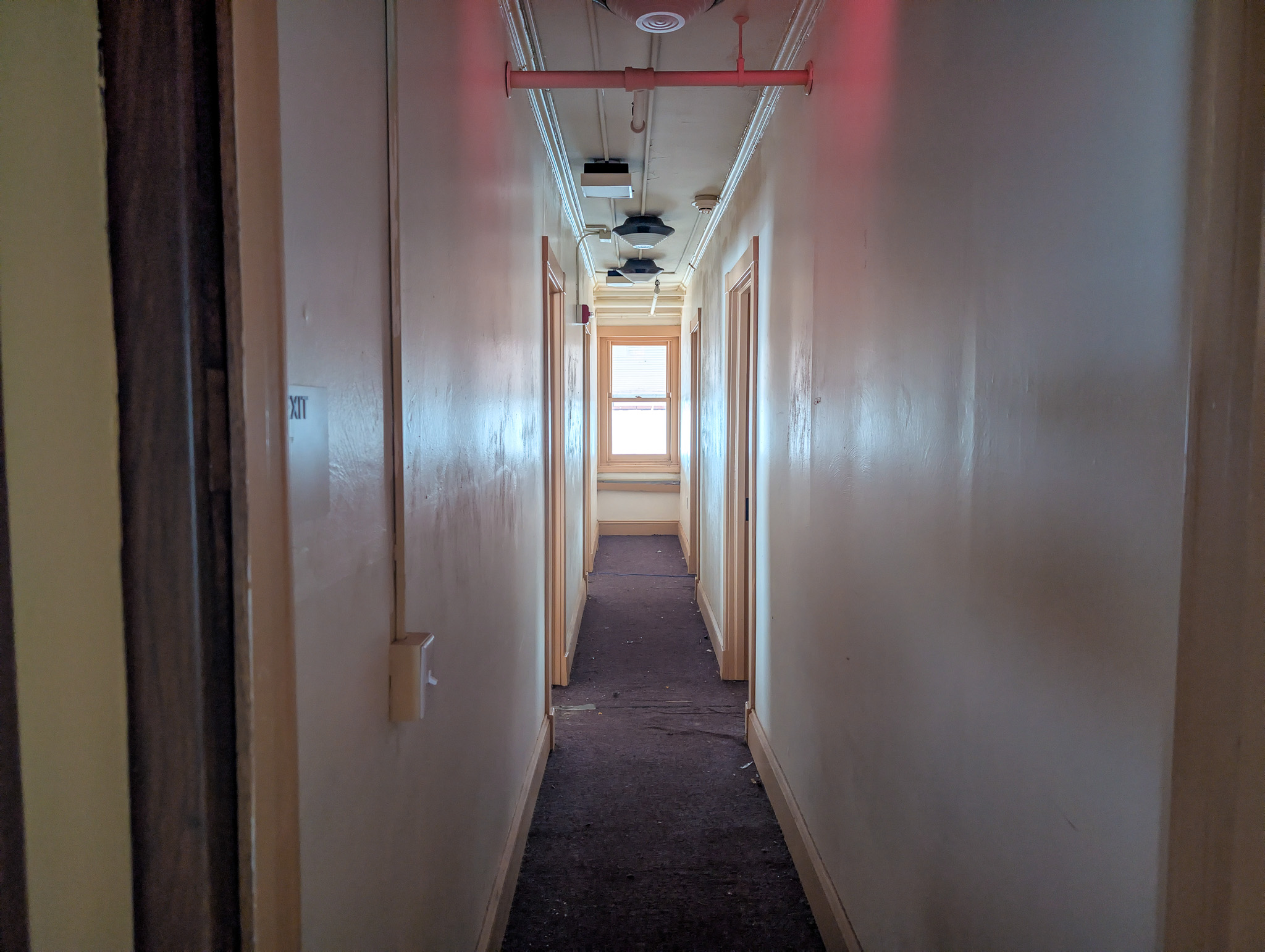
A Way Forward for the Reading Pagoda
Conservation and preservation should always be priority on Mount Penn. Historically, whenever the Pagoda requires money there are those who call for the city to rid themselves of the burden of having to care for it by either tearing it down or selling it to a private entity. Tearing down one of the most unique structures in the country, one so symbolic of our area, is just as asinine a thought as it was during WWII. Even suggesting its sale is short-sighted and would be a complete disregard to Mould’s intention of that land belonging to the public. That said, there does need to be a way forward with the Pagoda sustaining itself and not creating a financial burden every decade.
This is no easy feat, as the building itself comes with limitations. The Pagoda’s footprint is 50 feet by 28 feet, which isn’t a whole lot of space. The first two floors, which have the largest capacity, only equate to less than 2800 usable square feet combined. Not to mention the fact that parking space is limited. Navigating what revenue generating options can realistically occupy the space has always been the challenge. A part of the Foundation’s job is to come up with sustainable usage plans for when the building is complete.

Construction will tentatively be commencing in early 2025 and set to last a few years. The bulk of the work to be done in here is a completely new HVAC system, plumbing system, and electrical system. All of these essential systems need to be updated to accommodate the amount of traffic the Pagoda gets as a tourist destination. The expected cost of these upgrades to just the building is around $5 million. Bids have been awarded to the Warko Group for mechanical, Hirneisen Electric, and Dolan Construction for the general contractor. My plan is to thoroughly document the construction process and use my platform and communication abilities to keep the public informed on what is being done.
The second phase of the project will be raising $7+ million to reinforce the stone retaining walls which hold the structure and parking area on the mountain. It should be noted that the walls are not currently at risk of failing, but they are aging and will need to be addressed in the coming years for guaranteed longevity into the future.
The Pagoda is woven into the cultural fabric of Berks County. Its legacy belongs solely to no one; not even Jonathan Mould or William Abbott Witman. It belongs to us collectively as it has within its lifespan endured all of the ebbs and flows of uncertain times with us alongside it. We trudge forward with times no less uncertain; yet like those who came before us, it is ours to protect in this moment.
Click here to make a donation to the Pagoda Restoration Fund

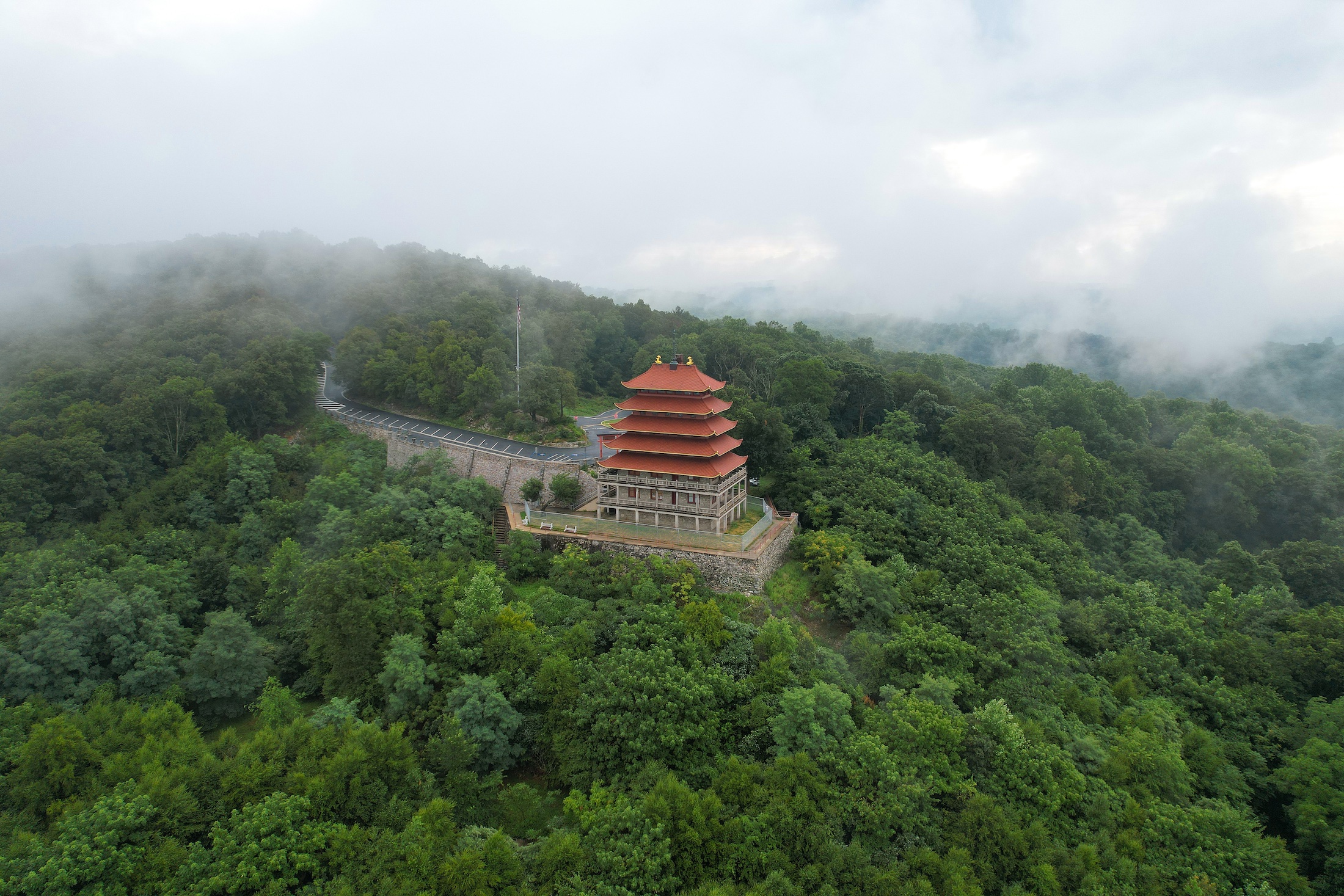
Great article
Thank you, Alexa for all your passion and research in local history. Always loved the Pagoda and surrounding area. Has anyone reached out to state legislators about a grant to help with the high cost of preserving a national landmark?
Great article, so thorough. As always!
Thank you for your dedication to revitalizing the Pagoda. It was always a place that we took out of town guests. I enjoy all of your articles and the history behind them.